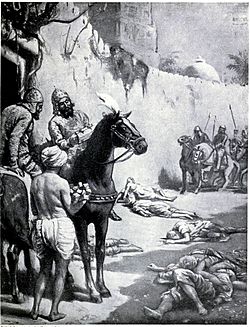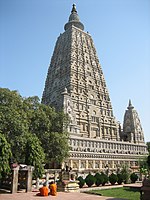Odantapuri
 Ruins of a fortress on the Hiranya Parvat hill in Bihar Sharif, where the Odantapuri monastery is believed to have been situated | |
| Location | Bihar, India |
|---|---|
| Coordinates | 25°11′49″N 85°31′05″E / 25.197°N 85.518°ECoordinates: 25°11′49″N 85°31′05″E / 25.197°N 85.518°E |
| Type | Centre of learning |
| History | |
| Founded | 8th–9th century CE |
| Abandoned | 13th century CE |
| Events | Destroyed by Muhammad bin Bakhtiyar Khalji in the late 12th-century |
Odantapuri (also called Odantapura or Uddandapura) was a prominent Buddhist Mahavihara in what is now Bihar, India. It is believed to have been established by Gopala I in the 8th century. It is considered the second oldest of India's Mahaviharas after Nalanda and was situated in Magadha.[1]
The vihara perished at the hands of Muhammad bin Bakhtiyar Khalji, a Turko-Muslim invader in late 1100s, when he launched multiple raids on Bihar and adjoining territories.[2]
Location[edit]
About the location of Odantapuri, S.C.Das depending on Sumpa Khan-po’s account thought that it was “erected on a hill near the town of modern Behar.”[3] The Tibetan scholar dge-’dun-chos-’phel stated : “On the railway line from Patna to Rajgir, there is a station called Bihar-Sharif. If one looks to the west after reaching the station, one will see a low mound." This is said to contain the ruins of Odantapuri Vihara.[4] Hence, the modern city of Bihar Sharif is identified as the location of Odantapuri Mahavihara.
History[edit]
Gopala, the founder of the Pala dynasty, who ascended the throne of Bengal in 750 CE; founded the monastery at Odantapuri. However, Bu-ston, the Tibetan Buddhist leader, was of the opinion that the Odantapuri monastery was built by Gopala's son and successor, Dharmapala.
Odantapuri was part of a network of five Mahaviharas in eastern India. The others were Nalanda, Vikramashila, Somapura, and Jagaddala.
Around the 11th century CE, while Nalanda was struggling for survival, Odantapuri “had a rival institution functioning under the royal patronage of Palas and, being a capital town, it must have inevitably snatched away the fortunes of Nalanda”.[5]
Influences[edit]
Tibetan sources indicate that the 8th century Samye monastery in Tibet was modeled upon Odantapuri.[6]
Destruction[edit]


In around 1193 CE, Muhammad bin Bakhtiyar Khalji, a Turkic chieftain out to make a name for himself, was in the service of a commander in Awadh. The Persian historian, Minhaj-i-Siraj in his Tabaqat-i Nasiri, recorded his deeds a few decades later. Khalji was assigned two villages on the border of Bihar which had become a political no-man's land. Sensing an opportunity, he began a series of plundering raids into Bihar and was recognised and rewarded for his efforts by his superiors. Emboldened, Khalji decided to attack a fort in Bihar and was able to successfully capture it, looting it of a great booty.[8]
Minhaj-i-Siraj wrote of this attack:[9]
Muhammad-i-Bakht-yar, by the force of his intrepidity, threw himself into the postern of the gateway of the place, and they captured the fortress, and acquired great booty. The greater number of the inhabitants of that place were Brahmans, and the whole of those Brahmans had their heads shaven; and they were all slain. There were a great number of books there; and, when all these books came under the observation of the Musalmans, they summoned a number of Hindus that they might give them information respecting the import of those books; but the whole of the Hindus had been killed. On becoming acquainted [with the contents of those books], it was found that the whole of that fortress and city was a college, and in the Hindui tongue, they call a college [مدرسه] Bihar.
This passage refers to an attack on a Buddhist monastery (the "Bihar" or Vihara) and its monks (the shaved Brahmans). The exact date of this event is not known with scholarly estimates ranging from 1197 to 1206.
While many historians believe that this monastery which was mistaken for a fort was Odantapura, some are of the opinion that it was Nalanda instead.[8] But the Tabaqat-i-Nasiri mentions "Adwand Bihar" as one of the territories acquired by Khalji,[10] whose name is very likely derived from the name "Uddandapura vihara". However, considering that the two Mahaviharas were only a few kilometres apart, both very likely befell a similar fate.[11]
Taranatha, the Tibetan monk, writes that the emperor of Magadha had fortified the monastery and stationed some soldiers with whom the monks joined in repulsing the invaders. He mentions that one of the early raids on Odantapuri was repulsed and the Turushka force of five hundreds was defeated.[2] According to the biography of the Tibetan monk-pilgrim, Dharmasvamin, who journeyed to India between 1234 and 1236; after its destruction, Odantapuri was turned into a military headquarters of the Turkic forces.[12]
Notes[edit]
- ↑ Anupam, Hitendra (2001). "SIGNIFICANCE OF TIBETAN SOURCES IN THE STUDY OF ODANTAPURI AND VIKARAMSILA MAHAVIHARS". Proceedings of the Indian History Congress. 61: 424–428.
- ↑ 2.0 2.1 Singh, Anand (2013). "'Destruction' and 'Decline' of Nālandā Mahāvihāra: Prejudices and Praxis". Journal of the Royal Asiatic Society of Sri Lanka. 58 (1): 23–49. ISSN 1391-720X.
- ↑ Sumpa Khan-po Yeçe Pal Jor, 1702-1775; Das, Sarat Chandra (1908). Pag sam jon zang. University of California. Calcutta, Pub. by the Presidency jail press.
{{cite book}}: CS1 maint: numeric names: authors list (link) - ↑ Barua, Dipak Kumar (1969). Viharas In Ancient India.
- ↑ Patil, D.R. (1963). The Antiquarian Remains in Bihar. p. 326.
- ↑ "Odantapuri | Buddhist school". Encyclopedia Britannica. Retrieved 2021-04-23.
- ↑ Sanyal, Sanjeev (15 November 2012). Land of seven rivers: History of India's Geography. Penguin Books Limited. pp. 130–1. ISBN 978-81-8475-671-5.
- ↑ 8.0 8.1 Chandra 2004, p. 41.
- ↑ Minhaj-ud-Din 1881, p. 552.
- ↑ H G Raverty (1873). Tabakat I Nasiri.
- ↑ Ghosh 1965, p. 14.
- ↑ Dutt, Sukumar (1988). Buddhist Monks and Monasteries of India: Their History and Their Contribution to Indian Culture. Motilal Banarsidass Publishe. ISBN 978-81-208-0498-2.


